Kiralux® CMOS Compact Scientific Cameras

e yjhtebyje54e6
tyrbjutbrj
- Monochrome, Color, or NIR-Enhanced CMOS Cameras
- 1.3 MP, 2.3 MP, 5.0 MP, 8.9 MP, or 12.3 MP Sensors
- High Quantum Efficiency and Low Read Noise
- Global Shutter for Imaging Fast-Moving Objects
Monochrome TIF Images (Shown with False Color):
Three-channel immunofluorescence image of a mouse brain
acquired using the CS895MU Camera.
Click here for the TIF composite.
(Sample prepared by Lynne Holtzclaw of the
NICDH Microscopy and Imaging Core Facility, NIH, Bethesda, MD)
CS135MUN
1.3 MP NIR-Enhanced,
Passive Cooling
CC895MU
8.9 MP Monochrome,
Fanless Active Cooling, Hermetically Sealed
LP126CU
12.3 MP Color,
Low-Profile,
Passive Cooling

Please Wait
| Scientific Camera Selection Guide |
|---|
| Zelux® CMOS (Smallest Profile) |
| Kiralux® CMOS |
| Kiralux Polarization-Sensitive CMOS |
| Quantalux® sCMOS (<1 e- Read Noise) |
Features
- Monochrome, Color, or NIR-Enhanced CMOS Sensor
- Fanless Cooling Reduces Dark Current without Adding Vibration and Image Blur
- CS Compact Series and LP Low-Profile Series Cameras Offer Passive Thermal Management
- CC Series Cooled Cameras Offer Active Thermoelectric Cooling
- Triggered and Bulb Exposure Modes
- Global Shutter
- USB 3.0 Interface
- ThorCam™ Software for Windows® 7, 10, and 11 Operating Systems
- SDK and Programming Interfaces Provide Support for:
- C, C++, C#, Python, and Visual Basic .NET APIs
- LabVIEW, MATLAB, and µManager Third-Party Software
- Compatible with 30 mm or 60 mm Cage Systems (See Mounting Features Sections Below)
- 1/4"-20 (M6 x 1.0)* Tapped Holes for Post Mounting
Thorlabs' Kiralux® Cameras with CMOS Sensors offer extremely low read noise and high sensitivity for demanding low-light imaging applications such as fluorescence microscopy. The global shutter scans the entire field of view simultaneously, allowing for imaging of fast moving objects. These cameras are available with monochrome, color, or NIR-enhanced sensors. The approximate position of the sensor is indicated by the engraved line on top of the camera body.
*Metric taps are available only with the LP Series Low-Profile Cameras.
Compact Package, Low-Profile Package, or Hermetically Sealed TE-Cooled Camera
Our Kiralux CMOS cameras are offered in three styles: a passively cooled compact package (CS Series Cameras); a low-profile, passively cooled package (LP Series Cameras); and a hermetically sealed package (CC Series Cameras) with a thermoelectric cooler (TEC) that cools the sensor. The CS, LP, and CC series cameras use a fan-free design to reduce dark current without adding image blur from vibrations. The CC series cameras' active TE-cooling provides greater dark current reduction when compared to the passively cooled cameras; however, the total dark current is also a function of exposure time. For high light levels requiring short exposure times (less than 500 ms), the passively cooled cameras are generally sufficient. We strongly recommend a cooled camera for applications with low light levels requiring exposures longer than 500 ms. Please see the Camera Noise tab for more details on the various sources of camera noise and how it impacts the choice between a standard and cooled camera.
Software and Triggering
Each camera includes a USB 3.0 interface for compatibility with most computers. Included with each camera is our ThorCam software for use with Windows® 7, 10, and 11 operating systems. Developers can leverage our fully featured API and SDK. Visit the ThorCam Software page to download the latest software, firmware, and programing interfaces.
Our cameras have triggering options that enable custom timing and system control; for more details, please see the Triggering tab. External triggering requires a connection to the auxiliary port of the camera. Accessory cables and boards to "break out" the individual signals are available below.
Removable Protective Window or IR Filter
The monochrome and NIR-enhanced cameras feature a clear window, while the color cameras feature an IR blocking filter. The C-mount adapter and other front end components are removable to provide access to the protective window. If the image spectrum must be limited, for example to eliminate unwanted near-infrared light, we offer a wide range of high-quality interference and colored glass optical filters that can easily be user-installed in both cameras.
Compact Kiralux Mounting Features
 Click to Enlarge Removing the C-Mount adapter and locking ring exposes the SM1 (1.035"-40) threading that can be used for custom assemblies using standard Thorlabs components. |
 Click to Enlarge An SM1 Lens Tube installed using the SM1-threaded aperture. |
 Click to Enlarge Four 4-40 tapped holes allow 30 mm Cage System components to be attached to the camera. Pictured is our CP13 Cage Plate with C-Mount threading. |
 Click to Enlarge A compact scientific CMOS camera installed on a Cerna® microscope using the WFA4100 Camera Tube. |
Cooled Kiralux Mounting Features
 Click to Enlarge The included hex key can be used to loosen the three cap screws on the C-mount adapter. An O-ring holds the protective window within the adapter. |
 Click to Enlarge Four 4-40 tapped holes allow 60 mm Cage System components to be attached to the camera. Pictured is our LCP02 Cage Plate Adapter for coupling to 30 mm Cage System components like the SM1-threaded CP33 Cage Plate. |
 Click to Enlarge A CC505MU camera is mounted on a Ø1" pedestal post using the 1/4"-20 tapped hole on the bottom of the housing. |
 Click to Enlarge A CC505MU camera installed on the LAURE1 Cerna® Trinoculars using a TC1X Camera Tube. |
Low-Profile Kiralux Mounting Features
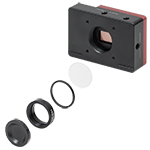 Click to Enlarge Removing the DC-CS1 C-mount adapter exposes the SM1 (1.035"-40) threading that can be used for custom assemblies using standard Thorlabs components. The filter window is held in place with an SM1RR retaining ring. |
 Click to Enlarge A low-profile Kiralux camera with a MVL8M23 machine vision lens installed using the DC-CS1 C-mount adapter. |
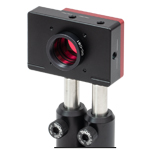 Click to Enlarge Two 1/4-20 (M6 x 1.0) tapped holes on the top and bottom of the low-profile series cameras can be used to provide repeatable positioning and protect against rotation of the camera while mounted. An LP126CU camera is mounted on two TR2 optical posts in two PH2 post holders. |
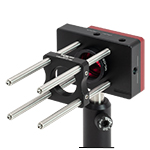 Click to Enlarge Four 4-40 tapped holes allow 30 mm Cage System components to be attached to the camera. Pictured is our CP13 Cage Plate with C-Mount threading attached to four ER4 cage rods threaded into the LP126CU low-profile camera. |
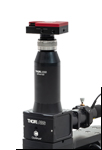 Click to Enlarge An LP126CU low-profile scientific CMOS camera installed on a Cerna® microscope using the WFA4100 Camera Tube. |
| Passively Cooled CMOS Cameras, Table 1 of 3 | |||||
|---|---|---|---|---|---|
| Item # | CS135MU | CS135CU | CS135MUN | CS235MU | CS235CU |
| Sensor Type | Monochrome CMOS | Color CMOS | NIR-Enhanced CMOS | Monochrome CMOS | Color CMOS |
| Effective Number of Pixels |
1280 x 1024 (H x V) | 1920 x 1200 (H x V) | |||
| Imaging Area | 6.144 mm x 4.915 mm (H x V) | 11.251 mm x 7.032 mm (H x V) | |||
| Pixel Size | 4.8 µm x 4.8 µm | 5.86 µm x 5.86 µm | |||
| Optical Formata | 1/2" (7.76 mm Diagonal) | 1/1.2" (13.3 mm Diagonal) | |||
| Max Frame Rate | 165.5 fps (Full Sensor) | 39.7 fps (Full Sensor) | |||
| ADCb Resolution | 10 Bits | 12 Bits | |||
| Sensor Shutter Type | Global | Global | |||
| Read Noise | <7.0 e- RMS | <7.0 e- RMS | |||
| Full Well Capacity | ≥10 000 e- | ≥30 000 e- | |||
| Exposure Time | 0.100 ms to 59269 ms in 0.001 ms Increments | 0.034 ms to 15167 ms in ~0.020 ms Increments | |||
| Vertical and Horizontal Digital Binningc |
1 x 1 to 5 x 5 | 1 x 1 to 16 x 16 | |||
| Region of Interest (ROI) | 16 x 2 Pixelsd to 1280 x 1024 Pixels, Rectangular | 92 x 4 Pixelsd to 1920 x 1200 Pixels, Rectangular | |||
| Dynamic Range | >60 dB | Up to 75 dB | |||
| Peak Quantum Efficiency | 59% at 550 nm | See Responsivity Plot | 60% at 600 nm | 78% at 500 nm | See Responsivity Plot |
| Responsivity Plots | Raw Data |
Raw Data |
Raw Data |
Raw Data |
Raw Data |
| Removable Optic | AR-Coated Window, Ravg < 0.5% per Surface (400 - 700 nm) |
IR Blocking Filter Raw Data |
AR-Coated Window, Ravg < 0.5% per Surface (650 - 1050 nm) |
AR-Coated Window, Ravg < 0.5% per Surface (400 - 700 nm) |
IR Blocking Filter Raw Data |
| USB Power Consumption | 3.85 W @ 165.5 fps (Full Sensor ROI) | 3.25 W @ 39.7 fps (Full Sensor ROI) | |||
| Ambient Operating Temperature | 10 °C to 40 °C (Non-Condensing) | ||||
| Storage Temperature | 0 °C to 55 °C | ||||
| Passively Cooled CMOS Cameras, Table 2 of 3 | ||||
|---|---|---|---|---|
| Item # | CS505MU1 | CS505MU | CS505CU1 | CS505CU |
| Sensor Type | Monochrome CMOS | Color CMOS | ||
| Effective Number of Pixels |
2448 x 2048 (H x V) | |||
| Imaging Area | 8.4456 mm x 7.0656 mm (H x V) | |||
| Pixel Size | 3.45 µm x 3.45 µm | |||
| Optical Formata | 2/3" (11 mm Diagonal) | |||
| Max Frame Rate | 35 fps (Full Sensor) | 53.2 fps (Full Sensor) | 35 fps (Full Sensor) | 53.2 fps (Full Sensor) |
| ADCb Resolution | 12 Bits | |||
| Sensor Shutter Type | Global | |||
| Read Noise | <2.5 e- RMS | |||
| Dark Currentc | <0.25 e-/pixel/s | N/A | ||
| Full Well Capacity | ≥10 000 e- | |||
| Exposure Time | 0.027 ms to 14235 ms in ~0.013 ms Increments |
0.021 ms to 7330 ms in ~0.007 ms Increments |
0.027 ms to 14235 ms in ~0.013 ms Increments |
0.021 ms to 7330 ms in ~0.007 ms Increments |
| Vertical and Horizontal Digital Binningd |
1 x 1 to 16 x 16 | |||
| Region of Interest (ROI) | 260 x 4 Pixelse to 2448 x 2048 Pixels, Rectangular | |||
| Dynamic Range | Up to 71 dB | |||
| Peak Quantum Efficiency | 72% (525 to 580 nm; Typical) | See Responsivity Plot | ||
| Responsivity Plots | Raw Data |
Raw Data |
||
| Removable Optic | AR-Coated Window, Ravg < 0.5% per Surface (400 - 700 nm) |
IR Blocking Filter Raw Data |
||
| USB Power Consumption | 3.6 W @ 35 fps (Full Sensor ROI) |
3.85 W @ 53.2 fps (Full Sensor ROI) |
3.6 W @ 35 fps (Full Sensor ROI) |
3.85 W @ 53.2 fps (Full Sensor ROI) |
| Ambient Operating Temperature |
10 °C to 40 °C (Non-Condensing) | |||
| Storage Temperature | 0 °C to 55 °C | |||
| Passively Cooled CMOS Cameras, Table 3 of 3 | ||||
|---|---|---|---|---|
| Item # | CS895MU | CS895CU | CS126MU | CS126CU |
| Sensor Type | Monochrome CMOS | Color CMOS | Monochrome CMOS | Color CMOS |
| Effective Number of Pixels |
4096 x 2160 (H x V) | 4096 x 3000 (H x V) | ||
| Imaging Area | 14.131 mm x 7.452 mm (H x V) | 14.131 mm x 10.350 mm (H x V) | ||
| Pixel Size | 3.45 µm x 3.45 µm | 3.45 µm x 3.45 µm | ||
| Optical Formata | 1" (16 mm Diagonal) | 1.1" (17.5 mm Diagonal) | ||
| Max Frame Rate | 30.15 fps (Full Sensor) | 21.7 fps (Full Sensor) | ||
| ADCb Resolution | 12 Bits | 12 Bits | ||
| Sensor Shutter Type | Global | Global | ||
| Read Noise | <2.5 e- RMS | <2.5 e- RMS | ||
| Dark Currentc | <0.25 e-/pixel/s | N/A | <0.25 e-/pixel/s | N/A |
| Full Well Capacity | ≥10 650 e- | ≥10 650 e- | ||
| Exposure Time | 0.028 ms to 14700.9 ms in ~0.014 ms Increments | 0.028 ms to 14700.9 ms in ~0.014 ms Increments | ||
| Vertical and Horizontal Digital Binningd |
1 x 1 to 16 x 16 | 1 x 1 to 16 x 16 | ||
| Region of Interest (ROI) | 260 x 4 Pixelse to 4096 x 2160 Pixels, Rectangular | 260 x 4 Pixelse to 4096 x 3000 Pixels, Rectangular | ||
| Dynamic Range | Up to 71 dB | Up to 71 dB | ||
| Peak Quantum Efficiency | 72% (525 to 580 nm; Typical) |
See Responsivity Plot | 72% (525 to 580 nm; Typical) |
See Responsivity Plot |
| Responsivity Plots | Raw Data |
Raw Data |
Raw Data |
Raw Data |
| Removable Optic | AR-Coated Window, Ravg < 0.5% per Surface (400 - 700 nm) |
IR Blocking Filter Raw Data |
AR-Coated Window, Ravg < 0.5% per Surface (400 - 700 nm) |
IR Blocking Filter Raw Data |
| USB Power Consumption | 3.88 W @ 30.15 fps (Full Sensor ROI) | 3.92 W @ 21.7 fps (Full Sensor ROI) | ||
| Ambient Operating Temperature |
10 °C to 40 °C (Non-Condensing) | |||
| Storage Temperature | 0 °C to 55 °C | |||
| Passively Cooled Low-Profile CMOS Cameras | ||
|---|---|---|
| Item # | LP126MU(/M) | LP126CU(/M) |
| Sensor Type | CMOS Monochrome | CMOS Color |
| Effective Number of Pixels | 4096 x 3000 (H x V) | |
| Imaging Area | 14.131 mm x 10.350 mm (H x V) | |
| Pixel Size | 3.45 µm x 3.45 µm | |
| Optical Formata | 1.1" (17.5 mm Diagonal) | |
| Max Frame Rateb | 21.7 fps (Full Sensor) | |
| ADCc Resolution | 12 Bits | |
| Sensor Shutter Type | Global | |
| Read Noise | <2.5 e- RMS | |
| Full Well Capacity | ≥10 650 e- | |
| Exposure Time | 0.028 ms to 14700.9 ms in ~0.014 ms Increments | |
| Vertical and Horizontal Digital Binning |
1 x 1 to 16 x 16 | |
| Region of Interest (ROI)d | 260 x 4 Pixels to 4096 x 3000 Pixels | |
| Dynamic Range | Up to 71 dB | |
| Peak Quantum Efficiency | 72% (525 to 580 nm, Typical) |
See Responsivity Plot |
| Responsivity Plots | Raw Data |
Raw Data |
| Removable Optic | AR-Coated Window, Ravg < 0.5% per Surface (400 - 700 nm) |
IR Blocking Filter Raw Data |
| USB Power Consumption | 3.92 W Max @ 21.7 fps Full Sensor ROI | |
| Ambient Operating Temperature |
10 °C to 40 °C (Non-Condensing) | |
| Storage Temperature | 0 °C to 55 °C | |
| Actively Cooled CMOS Cameras | |||
|---|---|---|---|
| Item # | CC505MU | CC895MU | CC126MU |
| Sensor Type | Actively Cooled Monochrome CMOS | ||
| Effective Number of Pixels |
2448 x 2048 (H x V) | 4096 x 2160 (H x V) | 4096 x 3000 (H x V) |
| Imaging Area | 8.4456 mm x 7.0656 mm (H x V) | 14.131 mm x 7.452 mm (H x V) | 14.131 mm x 10.350 mm (H x V) |
| Pixel Size | 3.45 µm x 3.45 µm | 3.45 µm x 3.45 µm | 3.45 µm x 3.45 µm |
| Optical Formata | 2/3" (11 mm Diagonal) | 1" (16 mm Diagonal) | 1.1" (17.5 mm Diagonal) |
| Max Frame Rate | 35 fps (Full Sensor) | 20.8 fps (Full Sensor) | 15.1 fps (Full Sensor) |
| ADCb Resolution | 12 Bits | 12 Bits | 12 Bits |
| Sensor Shutter Type | Global | Global | Global |
| Read Noise | <2.5 e- RMS | <2.5 e- RMS | <2.5 e- RMS |
| Dark Currentc | <0.066 e-/pixel/s | <0.04 e-/pixel/s | <0.035 e-/pixel/s |
| Full Well Capacity | ≥10 000 e- | ≥10 650 e- | ≥10 650 e- |
| Exposure Time | 0.027 ms to 14235 ms in ~0.013 ms Increments | 0.036 ms to 22795 ms in ~0.022 ms Increments | 0.028 ms to 14700.9 ms in ~0.014 ms Increments |
| Vertical and Horizontal Digital Binningd |
1 x 1 to 16 x 16 | 1 x 1 to 16 x 16 | 1 x 1 to 16 x 16 |
| Region of Interest (ROI) | 260 x 4 Pixelse to 2448 x 2048 Pixels, Rectangular | 260 x 4 Pixelse to 4096 x 2160 Pixels, Rectangular | 260 x 4 Pixelse to 4096 x 3000 Pixels, Rectangular |
| Dynamic Range | Up to 71 dB | Up to 71 dB | Up to 71 dB |
| Peak Quantum Efficiency | 72% (525 to 580 nm; Typical) |
72% (525 to 580 nm; Typical) |
72% (525 to 580 nm; Typical) |
| Responsivity Plots | Raw Data |
Raw Data |
Raw Data |
| Removable Optic | AR-Coated Window, Ravg < 0.5% per Surface (400 - 700 nm) |
AR-Coated Window, Ravg < 0.5% per Surface (400 - 700 nm) |
AR-Coated Window, Ravg < 0.5% per Surface (400 - 700 nm) |
| USB Power Consumption | 3.6 W @ 35 fps (Full Sensor ROI) | 3.7 W @ 20.8 fps (Full Sensor ROI) | 3.7 W @ 15.1 fps (Full Sensor ROI) |
| Cooling Power Consumption | 12.6 W (Max) | 12.6 W (Max) | 12.6 W (Max) |
| Ambient Operating Temperature | 10 °C to 40 °C (Non-Condensing) | ||
| Sensor Temperature in Cooling Mode |
-10 °C to 20 °C (20 °C Below Ambient) | -5 °C to 25 °C (15 °C Below Ambient) | -5 °C to 25 °C (15 °C Below Ambient) |
| Storage Temperature | 0 °C to 55 °C | ||
| Example Frame Ratesa,b,c | |||||
|---|---|---|---|---|---|
| CS135xx Example Frame Rates at 0.1 ms Exposure Time |
CS895xx Example Frame Rates at 1 ms Exposure Time |
CC505MU Example Frame Rates at 1 ms Exposure Time |
|||
| Region of Interest | Frame Rate | Region of Interest | Frame Rate | Region of Interest | Frame Rate |
| Full Sensor (1280 x 1024) | 165.5 fps | Full Sensor (4096 x 2160) | 30.15 fps | Full Sensor (2448 x 2048) | 35 fps |
| Half Sensor (640 x 512) | 520.6 fps | Half Sensor (2048 x 1080) | 63.3 fps | Half Sensor (1224 x 1024) | 68 fps |
| 1/10 Sensor (128 x 102) | 3469 fps | ~1/10 Sensor (410 x 216) | 272.3 fps | ~1/10 Sensor (260 x 208) | 290 fps |
| Minimum ROI (16 x 2) | 6712 fps | Minimum ROI (260 x 4) | 1426 fps | Minimum ROI (260 x 4) | 887.6 fps |
| CS505xx1 Example Frame Rates at 1 ms Exposure Time |
LP126xx(/M) and CS126xx Example Frame Rates at 1 ms Exposure Time |
CC895MU Example Frame Rates at 1 ms Exposure Time |
|||
| Region of Interest | Frame Rate | Region of Interest | Frame Rate | Region of Interest | Frame Rate |
| Full Sensor (2448 x 2048) | 35 fps | Full Sensor (4096 x 3000) | 21.7 fps | Full Sensor (4096 x 2160) | 20.8 fps |
| Half Sensor (1224 x 1024) | 68 fps | Half Sensor (2048 x 1500) | 46.1 fps | Half Sensor (2048 x 1080) | 40.8 fps |
| ~1/10 Sensor (260 x 208) | 290 fps | ~1/10 Sensor (410 x 300) | 206.1 fps | ~1/10 Sensor (410 x 216) | 175.4 fps |
| Minimum ROI (260 x 4) | 887.6 fps | Minimum ROI (260 x 4) | 914.4 fps | Minimum ROI (260 x 4) | 922 fps |
| CS505xx Example Frame Rates at 1 ms Exposure Time |
CS235xx Example Frame Rates at 1 ms Exposure Time |
CC126MU Example Frame Rates at 1 ms Exposure Time |
|||
| Region of Interest | Frame Rate | Region of Interest | Frame Rate | Region of Interest | Frame Rate |
| Full Sensor (2448 x 2048) | 53.2 fps | Full Sensor (1920 x 1200) | 39.7 fps | Full Sensor (4096 x 3000) | 15.1 fps |
| Half Sensor (1224 x 1024) | 133.7 fps | Half Sensor (960 x 600) | 75.8 fps | Half Sensor (2048 x 1500) | 29.8 fps |
| ~1/10 Sensor (260 x 208) | 563.2 fps | ~1/10 Sensor (192 x 120) | 277.8 fps | ~1/10 Sensor (410 x 300) | 132.9 fps |
| Minimum ROI (260 x 4) | 947.3 fps | Minimum ROI (92 x 4) | 781.3 fps | Minimum ROI (260 x 4) | 869.6 fps |
| Form Factor | Kiralux Compact Scientific (CS Series Cameras) |
Kiralux Low-Profile Scientific (LP Series Cameras) |
Kiralux Cooled Scientific (Item #s CC505MU, CC895MU, & CC126MU) |
|---|---|---|---|
| Max Filter Thickness When Using C-Mount Adapter | 0.050" (1.270 mm) | 0.039" (1.0 mm) | 0.079" (2.0 mm) |
| Mounting Features | Two 1/4"-20 Holes, One on Top & Bottom Four 4-40 Holes for 30 mm Cage Compatibility SM1 (1.035"-40) Threaded Aperture When C-Mount Adapter is Removed |
Five 1/4"-20 (M6 x 1.0) Holes, Two Each on Top & Bottom, One on Side Four 4-40 Holes for 30 mm Cage Compatibility SM1 (1.035"-40) Threaded Aperture When C-Mount Adapter is Removed |
Six 1/4"-20 Holes, Two Each on Top & Bottom, One on Each Side Four 4-40 Holes for 60 mm Cage Compatibility |
| Housing Dimensions | 2.77" x 2.38" x 1.88" (70.4 mm x 60.3 mm x 47.6 mm) |
3.00" x 2.00" x 0.90" (76.2 mm x 50.8 mm x 22.9 mm) |
4.29" x 4.13" x 4.13" (109.0 mm x 104.8 mm x 104.8 mm) |
| Cooling | Passive Cooling | Passive Cooling | Active Thermoelectric Cooling (See Table Above) |
| Cooling Mode Power Consumption | N/A | N/A | 12.6 W (Max) |
| Power Supply | Powered by USB 3.0 from Host PC | Powered by USB 3.0 from Host PC | Camera Powered by USB 3.0 from Host PC Auxillary Power Supply for TE-Cooling (100 - 240 VAC @ 50 - 60 Hz) |
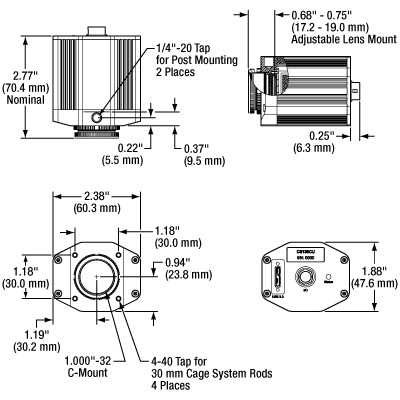
Click to Enlarge
Mechanical Drawing of the Compact Kiralux® Camera Housing. All cameras share the same dimensions; the CS135CU camera is shown as an example.

Click to Enlarge
Mechanical Drawing of the Actively Cooled Camera Housing
(Item #s CC505MU, CC895MU, & CC126MU)

Click to Enlarge
Mechanical Drawing of the Low-Profile Camera Housing
(Item #s LP126MU, LP126MU/M, LP126CU, and LP126CU/M)
Camera Back Panel Connector Locations
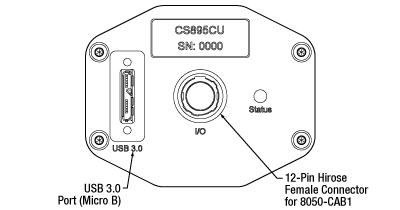
Back panel of Compact Kiralux Cameras. The CS895CU is shown as an example. For the I/O connector pin assignments, please see the Auxiliary (I/O) Connector section below.

Back panel of the Cooled Kiralux Cameras. For the I/O connector pin assignments, please see the Auxiliary (I/O) Connector section below.
 Side panel of the Low-Profile Kiralux Cameras showing the three
Side panel of the Low-Profile Kiralux Cameras showing the three LVTTL (0 - 3.3 V) MMCX connector ports. Maximum trigger (TRIG IN) voltage may not exceed +5 V.

Top panel of the Low-Profile Kiralux Cameras showing the USB 3.0 connector port.
TSI-IOBOB and TSI-IOBOB2 Break-Out Board Connector Locations

Click to Enlarge
TSI-IOBOB
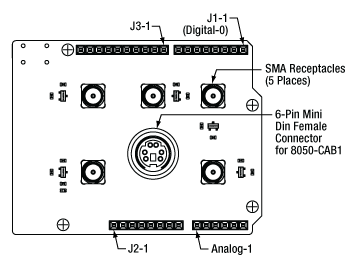
Click to Enlarge
TSI-IOBOB2
| TSI-IOBOB and TSI-IOBOB2 Connector | 8050-CAB1 Connectors | Camera Auxiliary (I/O) Port |
|---|---|---|
 Female 6-Pin Mini Din Female Connector |
 Male 6-Pin Mini Din Male Connector (TSI-IOBOB end of Cable) 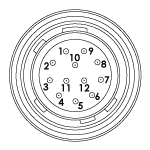 Male 12-Pin Hirose Connector (Camera end of Cable) |
 Female 12-Pin Hirose Connector (Auxiliary Port on Camera) |
Auxiliary (I/O) Connector
The cameras and the break-out boards feature female connectors; the cameras have a 12 pin Hirose connector, while the break out boards have a 6-pin Mini-DIN connector. The 8050-CAB1 cable features male connectors on both ends: a 12-pin connector for connecting to the camera and a 6-pin Mini-DIN connector for the break-out boards. Pins 1, 2, 3, 5, and 6 are each connected to the center pin of an SMA connector on the break-out boards, while pin 4 (ground) is connected to each SMA connector housing. To access one of the I/O functions not available with the 8050-CAB1, the user must fabricate a cable using shielded cabling in order for the camera to adhere to CE and FCC compliance; additional details are provided in the camera manual.
| Camera I/O Pin # |
TSI-IOBOB and TSI-IOBOB2 Pin # |
Signal | Description |
|---|---|---|---|
| 1 | - | GND | The electrical ground for the camera signals. |
| 2 | - | GND | The electrical ground for the camera signals. |
| 3 | - | GND | The electrical ground for the camera signals. |
| 4 | 6 | STROBE_OUT (Output) |
An LVTTL output that is high during the actual sensor exposure time when in continuous, overlapped exposure mode. It is typically used to synchronize an external flash lamp or other device with the camera. |
| 5 | 3 | TRIGGER_IN (Input) |
An LVTTL input used to trigger exposures. Transitions can occur from the high to low state or from the low to high state as selected in ThorCam; the default is low to high. This input is +5 V tolerant (5.5 V Max) |
| 6 | 1 | LVAL_OUT (Output) |
Refers to "Line Valid." It is an active-high LVTTL signal and is asserted during the valid pixel period on each line. It returns low during the inter-line period between each line and during the inter-frame period between each frame. |
| 7 | - | OPTO I/O_OUT STROBE (Output) |
This is an optically isolated output signal. The user must provide a pull-up resistor to an external voltage source of 2.5 V to 20 V. The pull-up resistor must limit the current into this pin to <40 mA. The default signal present on pin 7 is the STROBE_OUT signal, which is effectively the Trigger Out signal as well. |
| 8 | - | OPTO I/O_RTN | This is the return connection for the OPTO I/O_OUT output and the OPTO I/O_IN input connections. This must be connected to the pull-up source for OPTO I/O_OUT or the driving source for the OPTO I/O_IN signals. |
| 9 | - | OPTO I/O_IN (Input) |
This is an optically isolated input signal used to trigger exposures. The user must provide a driving source from 3.3 V to 10 V. An internal series resistor limits the current to <50 mA at 10 V. |
| 10 | 4 | GND | The electrical ground for the camera signals. |
| 11 | - | GND | The electrical ground for the camera signals. |
| 12 | 5 | FVAL_OUT (Output) |
Refers to "Frame Valid." It is a LVTTL output that is high during active readout lines and returns low between frames. |
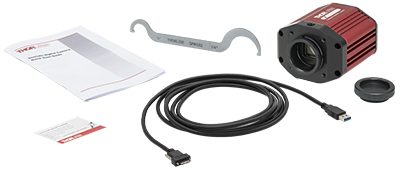
Click to Enlarge
Compact Kiralux CMOS Camera with Included Accessories
The following accessories are included with each Compact Scientific Camera:

Click to Enlarge
Low-Profile Kiralux CMOS Camera with Included Accessories
The following accessories are included with each Low-Profile Scientific Camera:

Click to Enlarge
Cooled Kiralux CMOS Camera with Included Accessories
The following accessories are included with each Cooled Scientific Camera:
- 3 m Long USB 3.0 Cable (Micro B to A - Appearance May Vary from Photo) with Bracket for PC Connection
- 5/64" Hex Key to Remove C-Mount Adapter
- Lens Cap
- 5 V / 3 A AC-DC Converter (For TEC Cooling Power Only; Not Shown)
- Quick-Start Guide and Manual Download Information Card
ThorCam™
ThorCam is a powerful image acquisition software package that is designed for use with our cameras on 32- and 64-bit Windows® 7, 10, or 11 systems. This intuitive, easy-to-use graphical interface provides camera control as well as the ability to acquire and play back images. Single image capture and image sequences are supported. Please refer to the screenshots below for an overview of the software's basic functionality.
Application programming interfaces (APIs) and a software development kit (SDK) are included for the development of custom applications by OEMs and developers. The SDK provides easy integration with a wide variety of programming languages, such as C, C++, C#, Python, and Visual Basic .NET. Support for third-party software packages, such as LabVIEW, MATLAB, and µManager* is available. We also offer example Arduino code for integration with our TSI-IOBOB2 Interconnect Break-Out Board.
*µManager control of 1.3 MP Kiralux cameras is not currently supported.
| Recommended System Requirementsa | |
|---|---|
| Operating System | Windows® 7, 10, or 11 (64 Bit) |
| Processor (CPU)b | ≥3.0 GHz Intel Core (i5 or Higher) |
| Memory (RAM) | ≥8 GB |
| Hard Drivec | ≥500 GB (SATA) Solid State Drive (SSD) |
| Graphics Cardd | Dedicated Adapter with ≥256 MB RAM |
| Motherboard | USB 3.0 (-USB) Cameras: Integrated Intel USB 3.0 Controller or One Unused PCIe x1 Slot (for Item # USB3-PCIE) GigE (-GE) Cameras: One Unused PCIe x1 Slot |
| Connectivity | USB or Internet Connectivity for Driver Installation |
Example Arduino Code for TSI-IOBOB2 Board
Click the button below to visit the download page for the sample Arduino programs for the TSI-IOBOB2 Shield for Arduino. Three sample programs are offered:
- Trigger the Camera at a Rate of 1 Hz
- Trigger the Camera at the Fastest Possible Rate
- Use the Direct AVR Port Mappings from the Arduino to Monitor Camera State and Trigger Acquisition
Click the Highlighted Regions to Explore ThorCam Features

Camera Control and Image Acquisition
Camera Control and Image Acquisition functions are carried out through the icons along the top of the window, highlighted in orange in the image above. Camera parameters may be set in the popup window that appears upon clicking on the Tools icon. The Snapshot button allows a single image to be acquired using the current camera settings.
The Start and Stop capture buttons begin image capture according to the camera settings, including triggered imaging.
Timed Series and Review of Image Series
The Timed Series control, shown in Figure 1, allows time-lapse images to be recorded. Simply set the total number of images and the time delay in between captures. The output will be saved in a multi-page TIFF file in order to preserve the high-precision, unaltered image data. Controls within ThorCam allow the user to play the sequence of images or step through them frame by frame.
Measurement and Annotation
As shown in the yellow highlighted regions in the image above, ThorCam has a number of built-in annotation and measurement functions to help analyze images after they have been acquired. Lines, rectangles, circles, and freehand shapes can be drawn on the image. Text can be entered to annotate marked locations. A measurement mode allows the user to determine the distance between points of interest.
The features in the red, green, and blue highlighted regions of the image above can be used to display information about both live and captured images.
ThorCam also features a tally counter that allows the user to mark points of interest in the image and tally the number of points marked (see Figure 2). A crosshair target that is locked to the center of the image can be enabled to provide a point of reference.
Third-Party Applications and Support
ThorCam is bundled with support for third-party software packages such as LabVIEW, MATLAB, and .NET. Both 32- and 64-bit versions of LabVIEW and MATLAB are supported. A full-featured and well-documented API, included with our cameras, makes it convenient to develop fully customized applications in an efficient manner, while also providing the ability to migrate through our product line without having to rewrite an application.
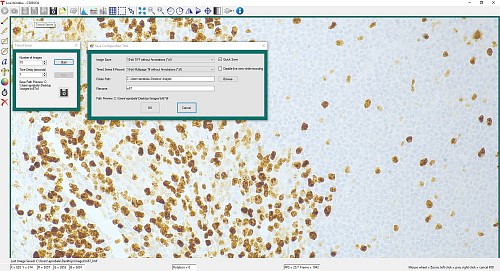
Click to Enlarge
Figure 1: A timed series of 10 images taken at 1 second intervals is saved as a multipage TIFF.

Click to Enlarge
Figure 2: A screenshot of the ThorCam software showing some of the analysis and annotation features. The Tally function was used to mark four locations in the image. A blue crosshair target is enabled and locked to the center of the image to provide a point of reference.
Performance Considerations
Please note that system performance limitations can lead to "dropped frames" when image sequences are saved to the disk. The ability of the host system to keep up with the camera's output data stream is dependent on multiple aspects of the host system. Note that the use of a USB hub may impact performance. A dedicated connection to the PC is preferred. USB 2.0 connections are not supported.
First, it is important to distinguish between the frame rate of the camera and the ability of the host computer to keep up with the task of displaying images or streaming to the disk without dropping frames. The frame rate of the camera is a function of exposure and readout (e.g. clock, ROI) parameters. Based on the acquisition parameters chosen by the user, the camera timing emulates a digital counter that will generate a certain number of frames per second. When displaying images, this data is handled by the graphics system of the computer; when saving images and movies, this data is streamed to disk. If the hard drive is not fast enough, this will result in dropped frames.
One solution to this problem is to ensure that a solid state drive (SSD) is used. This usually resolves the issue if the other specifications of the PC are sufficient. Note that the write speed of the SSD must be sufficient to handle the data throughput.
Larger format images at higher frame rates sometimes require additional speed. In these cases users can consider implementing a RAID0 configuration using multiple SSDs or setting up a RAM drive. While the latter option limits the storage space to the RAM on the PC, this is the fastest option available. ImDisk is one example of a free RAM disk software package. It is important to note that RAM drives use volatile memory. Hence it is critical to ensure that the data is moved from the RAM drive to a physical hard drive before restarting or shutting down the computer to avoid data loss.
Triggered Camera Operation
Our scientific cameras have three externally triggered operating modes: streaming overlapped exposure, asynchronous triggered acquisition, and bulb exposure driven by an externally generated trigger pulse. The trigger modes operate independently of the readout (e.g., binning) settings as well as gain and offset. Figures 1 through 3 show the timing diagrams for these trigger modes, assuming an active low external LVTTL trigger.

Click to Enlarge
Figure 1: Streaming overlapped exposure mode. When the external trigger goes low, the exposure begins, and continues for the software-selected exposure time, followed by the readout. This sequence then repeats at the set time interval. Subsequent external triggers are ignored until the camera operation is halted. For the definition of the LVTTL signals, please see the Pin Diagrams tab.

Click to Enlarge
Figure 2: Asynchronous triggered acquisition mode. When the external trigger signal goes low, an exposure begins for the preset time, and then the exposure is read out of the camera. During the readout time, the external trigger is ignored. Once a single readout is complete, the camera will begin the next exposure only when the external trigger signal goes low.
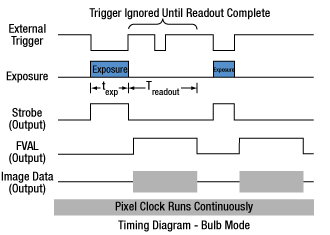
Click to Enlarge
Figure 3: Bulb exposure mode. The exposure begins when the external trigger signal goes low and ends when the external trigger signal goes high. Trigger signals during camera readout are ignored.
| Delay Times | ||
|---|---|---|
| Item # | External Trigger Delay |
Fixed Exposure Time Error |
| CS135xx | 3.5 µs | 28 µs |
| CS235xx | 60.7 µs | 13.72 µs |
| CS505xx | 100 ns | 13.72 µs |
| CC505MU | 270 ns | 13.72 µs |
| CS895xx | 100 ns | 14.26 µs |
| CC895MU | 270 ns | 14.26 µs |
| CS126xx | 75 ns | 14.26 µs |
| LP126xx | 75 ns | 14.26 µs |
| CC126MU | 270 ns | 14.26 µs |
Camera Specific Timing Considerations
Due to the general operation of our Kiralux CMOS sensor cameras, as well as typical system propagation delays, the timing relationships shown above are subject to the following considerations:
- The delay from the external trigger to the start of the exposure and strobe signals for all triggered modes (standard and PDX/Bulb) is specified in the table to the right.
- For PDX/Bulb mode triggered exposures, in addition to the start delay discussed above, there is also a fixed exposure time error AFTER the falling edge of the external trigger. This is inherent in the sensor operation. It is important to note that the Strobe_out signal includes the additional fixed exposure time error and therefore is a better representation of the actual exposure time. Our suggestion is to use the Strobe_out signal to measure your exposure time and adjust your PDX mode trigger pulse accordingly. The fixed exposure time errors are also specified in the table to the right.
External Triggering
External triggering enables these cameras to be easily integrated into systems that require the camera to be synchronized to external events. The Strobe Output goes high to indicate exposure; the strobe signal may be used in designing a system to synchronize external devices to the camera exposure. External triggering requires a connection to the auxiliary port of the camera. We offer the 8050-CAB1 auxiliary cable as an optional accessory for the CS series and CC series cameras. Two options are provided to "break out" individual signals. The TSI-IOBOB provides SMA connectors for each individual signal. Alternately, the TSI-IOBOB2 also provides the SMA connectors with the added functionality of a shield for Arduino boards that allows control of other peripheral equipment. More details on these three optional accessories are provided below.
The LP126xx(/M) low-profile camera series uses MMCX-to-BNC cables and does not require an 8050-CAB1 cable or TSI-IOBOB board. Three CA3339 MMCX-to-BNC cables and one CABU32 USB 3.0 are included with the LP126xx(/M) low-profile camera.
Trigger settings are adjusted using the ThorCam software. Figures 4 shows the General Settings tab and Figure 5 shows the Hardware Triggering tab. Settings can be adjusted as follows:
- "Hardware Triggering" Tab (Figure 5) Mode Set to "None": The camera will simply acquire the number of frames in the "Frames per Trigger" box when the capture button is pressed in ThorCam.
- "Hardware Triggering" Tab ModeSet to "Standard": There are Two Possible Scenarios:
- "Frames per Trigger" (Figure 4 Bottom) Set to Zero or >1: The camera will operate in streaming overlapped exposure mode (Figure 1).
- "Frames per Trigger" Set to 1: Then the camera will operate in asynchronous triggered acquisition mode (Figure 2).
- "Hardware Triggering" Tab Mode Set to "Bulb (PDX) Mode": The camera will operate in bulb exposure mode, also known as Pulse Driven Exposure (PDX) mode (Figure 3).
In addition, the polarity of the trigger can be set to "On High" (exposure begins on the rising edge) or "On Low" (exposure begins on the falling edge) in the "Hardware Triggering" tab seen in Figure 5.
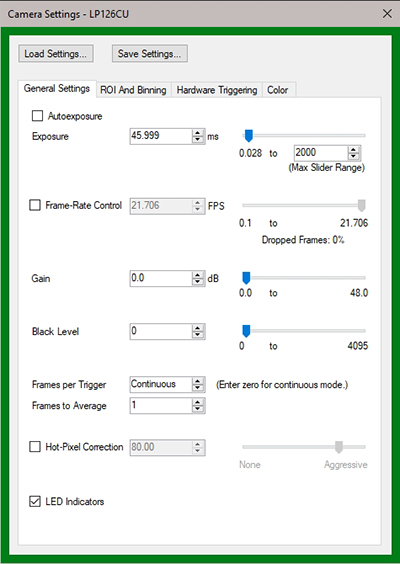
Figure 4: The ThorCam Camera General Settings tab. The "Frames per Trigger" and "Frames to Average" selectors are can be seen in towards to bottom of the window.
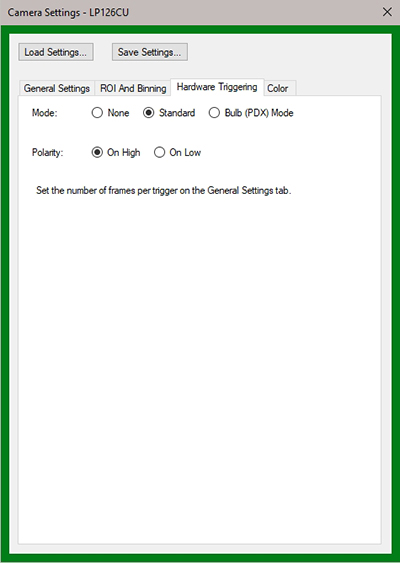
Figure 5: The ThorCam Hardware Triggering tab with Mode and Polarity selectors.
Example Camera Triggering Configuration using Scientific Camera Accessories
An example of how camera triggering can be integrated into system control is shown in Figure 6 for a CS series compact camera and in Figure 7 for an LP series low-profile camera. The schematic in Figure 6 shows the CS series compact camera connected to the TSI-IOBOB2 break-out board / shield for Arduino using a 8050-CAB1 cable (available below). The schematic in Figure 7 shows an LP series low-profile camera connected to the TSI-IOBOB2 break-out board / shield for Arduino using three CA3439 MMCX-to-SMA cables (available below). The pins on the shield can be used to deliver signals to simultaneously control other peripheral devices, such as light sources, shutters, or motion control devices. Once the control program is written to the Arduino board, the USB connection to the host PC can be removed, allowing for a stand-alone system control platform; alternately, the USB connection can be left in place to allow for two-way communication between the Arduino and the PC. Configuring the external trigger mode is done using ThorCam as described above.

Click to Enlarge
Figure 7: A schematic showing a system using the TSI-IOBOB2 to facilitate system integration and control for an LP series camera.

Click to Enlarge
Figure 6: A schematic showing a system using the TSI-IOBOB2 to facilitate system integration and control for a CS series camera.
Camera Noise and Temperature
Overview
When purchasing a camera, an important consideration is whether or not the application will require a cooled sensor. Generally, most applications have high signal levels and do not require cooling. However, for certain situations, generally under low light levels where long exposures are necessary, cooling will provide a benefit. In the tutorial below, we derive the following "rule of thumb": for exposures less than 1 second, a standard camera is generally sufficient; for exposures greater than 1 second, cooling could be beneficial; for exposures greater than 5 seconds, cooling is generally recommended; and for exposures above 10 seconds, cooling is usually required. If you have questions about which domain your application will fall, you might consider estimating the signal levels and noise sources by following the steps detailed in the tutorial below, where we present sample calculations using the specifications for our 1.4 megapixel cameras. Alternatively you can contact us, and one of our scientific camera specialists will help you decide which camera is right for you.
Sources of Noise
Noise in a camera image is the aggregate spatial and temporal variation in the measured signal, assuming constant, uniform illumination. There are several components of noise:
- Dark Shot Noise (σD): Dark current is a current that flows even when no photons are incident on the camera. It is a thermal phenomenon resulting from electrons spontaneously generated within the silicon chip (valence electrons are thermally excited into the conduction band). The variation in the amount of dark electrons collected during the exposure is the dark shot noise. It is independent of the signal level but is dependent on the temperature of the sensor as shown in Table 1.
- Read Noise (σR): This is the noise generated in producing the electronic signal. This results from the sensor design but can also be impacted by the design of the camera electronics. It is independent of signal level and temperature of the sensor, and is larger for faster CCD pixel clock rates.
- Photon Shot Noise (σS): This is the statistical noise associated with the arrival of photons at the pixel. Since photon measurement obeys Poisson statistics, the photon shot noise is dependent on the signal level measured. It is independent of sensor temperature.
- Fixed Pattern Noise (σF): This is caused by spatial non-uniformities of the pixels and is independent of signal level and temperature of the sensor. Note that fixed pattern noise will be ignored in the discussion below; this is a valid assumption for the CCD cameras sold here but may need to be included for other non-scientific-grade sensors.
Total Effective Noise
The total effective noise per pixel is the quadrature sum of each of the noise sources listed above:

Here, σD is the dark shot noise, σR is the read noise (for sample calculations, we will use our 1.4 megapixel cameras, which use the ICX285AL sensor. Typically the read noise is less than 10 e- for scientific-grade cameras using the ICX285AL CCD; we will assume a value of 10 e- in this tutorial), and σS is the photon shot noise. If σS>>σD and σS>>σR, then σeff is approximately given by the following:

Again, fixed pattern noise is ignored, which is a good approximation for scientific-grade CCDs but may need to be considered for non-scientific-grade sensors.
| Temperature | Dark Current (ID) |
|---|---|
| -20 °C | 0.1 e-/(s•pixel) |
| 0 °C | 1 e-/(s•pixel) |
| 25 °C | 5 e-/(s•pixel) |
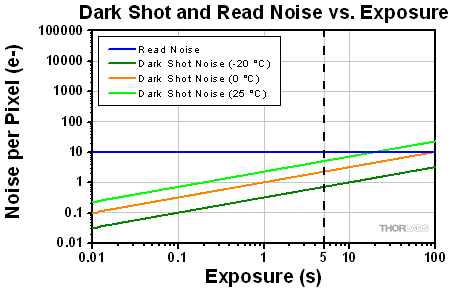
Click to Enlarge
Figure 1: Plot of dark shot noise and read noise as a function of exposure for three sensor temperatures for a sample camera. This plot uses logarithmic scales for both axes.The dotted vertical line at 5 s indicates the values calculated as the example in the text.
Dark Shot Noise and Sensor Temperature
As mentioned above, the dark current is a thermal effect and can therefore be reduced by cooling the sensor. Table 1 lists typical dark current values for a sample camera with a CCD sensor. As the dark current results from spontaneously generated electrons, the dark current is measured by simply "counting" these electrons. Since counting electrons obeys Poisson statistics, the noise associated with the dark current ID is proportional to the square root of the number of dark electrons that accumulate during the exposure. For a given exposure, the dark shot noise, σD, is therefore the square root of the ID value from Table 1 (for a given sensor temperature) multiplied by the exposure time t in seconds:

Since the dark current decreases with decreasing temperature, the associated noise can be decreased by cooling the camera. For example, assuming an exposure of 5 seconds, the dark shot noise levels for the three sensor temperatures listed in the table are



Figure 1, which is a plot of the dark shot noise as a function of exposure for the three temperatures listed in Table 1, illustrates how the dark shot noise increases with increasing exposure. Figure 1 also includes a plot of the upper limit of the read noise.
If the photon shot noise is significantly larger than the dark shot noise, then cooling provides a negligible benefit in terms of the noise, and our standard package cameras will work well.
Photon Shot Noise
If S is the number of "signal" electrons generated when a photon flux of N photons/second is incident on each pixel of a sensor with a quantum efficiency QE and an exposure duration of t seconds, then

From S, the photon shot noise, σS, is given by:

Example Calculations (Using our 1.4 Megapixel Cameras)
If we assume that there is a sufficiently high photon flux and quantum efficiency to allow for a signal S of 10,000 e- to accumulate in a pixel with an exposure of 5 seconds, then the estimated shot noise, σS, would be the square root of 10,000, or 100 e-. The read noise is 10 e- (independent of exposure time). For an exposure of 5 seconds and sensor temperatures of 25, 0, and -25 °C, the dark shot noise is given in equation (4). The effective noise is:




The signal-to-noise ratio (SNR) is a useful figure of merit for image quality and is estimated as:

From Equation 7, the SNR values for the three sensor temperatures are:
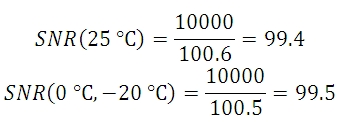
As the example shows, there is a negligible benefit to using a cooled camera compared to a non-cooled camera operating at room temperature, and the photon shot noise is the dominant noise source in this example. In this case our standard package cameras should therefore work quite well.
However, if the light levels were lower such that a 100 second exposure was required to achieve 900 e- per pixel, then the shot noise would be 30 e-. The estimated dark shot noise would be 22.4 e- at 25 °C, while at -20 °C the dark shot noise would be 3.2 e-. The total effective noise would be

From Equation 8, the SNR values are
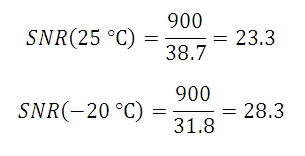
| Exposure | Camera Recommendation |
|---|---|
| <1 s | Standard Non-Cooled Camera Generally Sufficient |
| 1 s to 5 s | Cooled Camera Could Be Helpful |
| 5 s to 10 s | Cooled Camera Recommended |
| >10 s | Cooled Camera Usually Required |
In this example, the dark shot noise is a more significant contributor to the total noise for the 25 °C sensor than for the -25 °C sensor. Depending on the application's noise budget, a cooled camera may be beneficial.
Figure 2 shows plots of the different noise components, including dark shot noise at three sensor temperatures, as a function of exposure time for three photon fluxes. The plots show that dark shot noise is not a significant contributor to total noise except for low signal (and consequently long exposure) situations. While the photon flux levels used for the calculations are given in the figure, it is not necessary to know the exact photon flux level for your application. Figure 2 suggests a general metric based on exposure time that can be used to determine whether a cooled camera is required if the exposure time can be estimated, and these results are summarized in Table 2. If you find that your dominant source of noise is due to the read noise, then we recommend running the camera at a lower CCD pixel clock rate of 20 MHz, since that will offer a lower read noise.
Figure 2: Noise from all sources as a function of exposure for three different photon fluxes: (a) low, (b) medium, and (c) high. In (c) the signal and photon shot noise saturate above approximately 20 seconds because the pixel becomes saturated at the corresponding incident photon levels. A quantum efficiency of 60% was used for the calculations. Note that these plots use logarithmic scales for both axes.
Other Considerations
Thermoelectric cooling should also be considered for long exposures even where the dark shot noise is not a significant contributor to total noise because cooling also helps to reduce the effects of hot pixels. Hot pixels cause a "star field" pattern that appears under long exposures. Figure 3 shows an example of this star field pattern for images taken using cameras with and without TEC cooling with an exposure of 10 seconds.
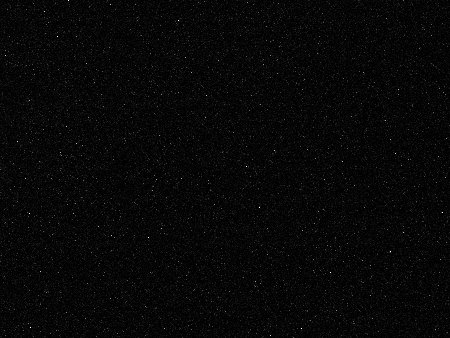
(a)

(b)
Figure 3: Images of the "star field" pattern that results from hot pixels using our (a) standard non-cooled camera and (b) our camera cooled to -20 °C. Both images were taken with an exposure of 10 seconds and with a gain of 32 dB (to make the hot pixels more visible). Please note that in order to show the pattern the images displayed here were cropped from the full-resolution 16 bit images. The full size 16 bit images may be downloaded here and viewed with software such as ImageJ, which is a free download.
Insights into Mounting Lenses to Thorlabs' Scientific Cameras
Scroll down to read about compatibility between lenses and cameras of different mount types, with a focus on Thorlabs' scientific cameras.
- Can C-mount and CS-mount cameras and lenses be used with each other?
- Do Thorlabs' scientific cameras need an adapter?
- Why can the FFD be smaller than the distance separating the camera's flange and sensor?
Click here for more insights into lab practices and equipment.
Can C-mount and CS-mount cameras and lenses be used with each other?

Click to Enlarge
Figure 1: C-mount lenses and cameras have the same flange focal distance (FFD), 17.526 mm. This ensures light through the lens focuses on the camera's sensor. Both components have 1.000"-32 threads, sometimes referred to as "C-mount threads".

Click to Enlarge
Figure 2: CS-mount lenses and cameras have the same flange focal distance (FFD), 12.526 mm. This ensures light through the lens focuses on the camera's sensor. Their 1.000"-32 threads are identical to threads on C-mount components, sometimes referred to as "C-mount threads."
The C-mount and CS-mount camera system standards both include 1.000"-32 threads, but the two mount types have different flange focal distances (FFD, also known as flange focal depth, flange focal length, register, flange back distance, and flange-to-film distance). The FFD is 17.526 mm for the C-mount and 12.526 mm for the CS-mount (Figures 1 and 2, respectively).
Since their flange focal distances are different, the C-mount and CS-mount components are not directly interchangeable. However, with an adapter, it is possible to use a C-mount lens with a CS-mount camera.
Mixing and Matching
C-mount and CS-mount components have identical threads, but lenses and cameras of different mount types should not be directly attached to one another. If this is done, the lens' focal plane will not coincide with the camera's sensor plane due to the difference in FFD, and the image will be blurry.
With an adapter, a C-mount lens can be used with a CS-mount camera (Figures 3 and 4). The adapter increases the separation between the lens and the camera's sensor by 5.0 mm, to ensure the lens' focal plane aligns with the camera's sensor plane.
In contrast, the shorter FFD of CS-mount lenses makes them incompatible for use with C-mount cameras (Figure 5). The lens and camera housings prevent the lens from mounting close enough to the camera sensor to provide an in-focus image, and no adapter can bring the lens closer.
It is critical to check the lens and camera parameters to determine whether the components are compatible, an adapter is required, or the components cannot be made compatible.
1.000"-32 Threads
Imperial threads are properly described by their diameter and the number of threads per inch (TPI). In the case of both these mounts, the thread diameter is 1.000" and the TPI is 32. Due to the prevalence of C-mount devices, the 1.000"-32 thread is sometimes referred to as a "C-mount thread." Using this term can cause confusion, since CS-mount devices have the same threads.
Measuring Flange Focal Distance
Measurements of flange focal distance are given for both lenses and cameras. In the case of lenses, the FFD is measured from the lens' flange surface (Figures 1 and 2) to its focal plane. The flange surface follows the lens' planar back face and intersects the base of the external 1.000"-32 threads. In cameras, the FFD is measured from the camera's front face to the sensor plane. When the lens is mounted on the camera without an adapter, the flange surfaces on the camera front face and lens back face are brought into contact.
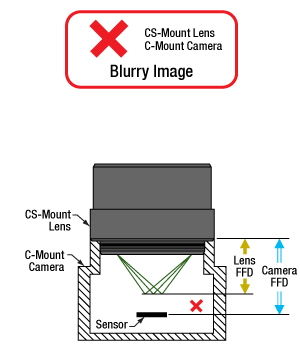
Click to Enlarge
Figure 5: A CS-mount lens is not directly compatible with a C-mount camera, since the light focuses before the camera's sensor. Adapters are not useful, since the solution would require shrinking the flange focal distance of the camera (blue arrow).
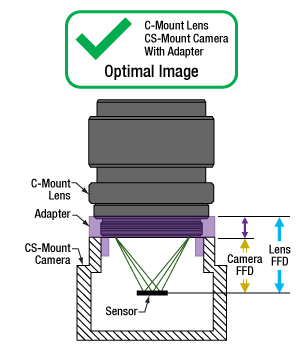
Click to Enlarge
Figure 4: An adapter with the proper thickness moves the C-mount lens away from the CS-mount camera's sensor by an optimal amount, which is indicated by the length of the purple arrow. This allows the lens to focus light on the camera's sensor, despite the difference in FFD.

Click to Enlarge
Figure 3: A C-mount lens and a CS-mount camera are not directly compatible, since their flange focal distances, indicated by the blue and yellow arrows, respectively, are different. This arrangement will result in blurry images, since the light will not focus on the camera's sensor.
Date of Last Edit: July 21, 2020
Do Thorlabs' scientific cameras need an adapter?

Click to Enlarge
Figure 6: An adapter can be used to optimally position a C-mount lens on a camera whose flange focal distance is less than 17.526 mm. This sketch is based on a Zelux camera and its SM1A10Z adapter.
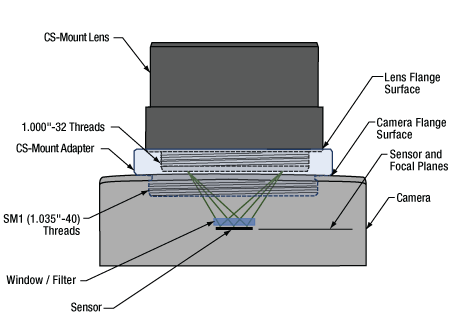
Click to Enlarge
Figure 7: An adapter can be used to optimally position a CS-mount lens on a camera whose flange focal distance is less than 12.526 mm. This sketch is based on a Zelux camera and its SM1A10 adapter.
All Kiralux™ and Quantalux® scientific cameras are factory set to accept C-mount lenses. When the attached C-mount adapters are removed from the passively cooled cameras, the
The SM1 threads integrated into the camera housings are intended to facilitate the use of lens assemblies created from Thorlabs components. Adapters can also be used to convert from the camera's C-mount configurations. When designing an application-specific lens assembly or considering the use of an adapter not specifically designed for the camera, it is important to ensure that the flange focal distances (FFD) of the camera and lens match, as well as that the camera's sensor size accommodates the desired field of view (FOV).
Made for Each Other: Cameras and Their Adapters
Fixed adapters are available to configure the Zelux cameras to meet C-mount and CS-mount standards (Figures 6 and 7). These adapters, as well as the adjustable C-mount adapters attached to the passively cooled Kiralux and Quantalux cameras, were designed specifically for use with their respective cameras.
While any adapter converting from SM1 to
The position of the lens' focal plane is determined by a combination of the lens' FFD, which is measured in air, and any refractive elements between the lens and the camera's sensor. When light focused by the lens passes through a refractive element, instead of just travelling through air, the physical focal plane is shifted to longer distances by an amount that can be calculated. The adapter must add enough separation to compensate for both the camera's FFD, when it is too short, and the focal shift caused by any windows or filters inserted between the lens and sensor.
Flexiblity and Quick Fixes: Adjustable C-Mount Adapter
Passively cooled Kiralux and Quantalux cameras consist of a camera with SM1 internal threads, a window or filter covering the sensor and secured by a retaining ring, and an adjustable C-mount adapter.
A benefit of the adjustable C-mount adapter is that it can tune the spacing between the lens and camera over a 1.8 mm range, when the window / filter and retaining ring are in place. Changing the spacing can compensate for different effects that otherwise misalign the camera's sensor plane and the lens' focal plane. These effects include material expansion and contraction due to temperature changes, positioning errors from tolerance stacking, and focal shifts caused by a substitute window or filter with a different thickness or refractive index.
Adjusting the camera's adapter may be necessary to obtain sharp images of objects at infinity. When an object is at infinity, the incoming rays are parallel, and location of the focus defines the FFD of the lens. Since the actual FFDs of lenses and cameras may not match their intended FFDs, the focal plane for objects at infinity may be shifted from the sensor plane, resulting in a blurry image.
If it is impossible to get a sharp image of objects at infinity, despite tuning the lens focus, try adjusting the camera's adapter. This can compensate for shifts due to tolerance and environmental effects and bring the image into focus.
Date of Last Edit: Aug. 2, 2020
Why can the FFD be smaller than the distance separating the camera's flange and sensor?
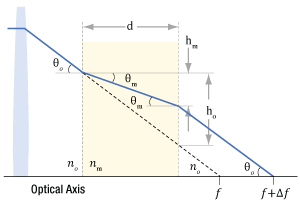
Click to Enlarge
Figure 9: Refraction causes the ray's angle with the optical axis to be shallower in the medium than in air (θm vs. θo ), due to the differences in refractive indices (nm vs. no ). After travelling a distance d in the medium, the ray is only hm closer to the axis. Due to this, the ray intersects the axis Δf beyond the f point.;

Click to Enlarge
Figure 8: A ray travelling through air intersects the optical axis at point f. The ray is ho closer to the axis after it travels across distance d. The refractive index of the air is no .
| Example of Calculating Focal Shift | |||
|---|---|---|---|
| Known Information | |||
| C-Mount FFD | f | 17.526 mm | |
| Total Glass Thickness | d | ~1.6 mm | |
| Refractive Index of Air | no | 1 | |
| Refractive Index of Glass | nm | 1.5 | |
| Lens f-Number | f / N | f / 1.4 | |
| Parameter to Calculate |
Exact Equations | Paraxial Approximation |
|
| θo | 20° | ||
| ho | 0.57 mm | --- | |
| θm | 13° | --- | |
| hm | 0.37 mm | --- | |
| Δf | 0.57 mm | 0.53 mm | |
| f + Δf | 18.1 mm | 18.1 mm | |
| Equations for Calculating the Focal Shift (Δf ) | ||
|---|---|---|
| Angle of Ray in Air, from Lens f-Number ( f / N ) |  |
|
| Change in Distance to Axis, Travelling through Air (Figure 8) |  |
|
| Angle of Ray to Axis, in the Medium (Figure 9) |
 |
|
| Change in Distance to Axis, Travelling through Optic (Figure 9) |  |
|
| Focal Shift Caused by Refraction through Medium (Figure 9) | Exact Calculation |
 |
| Paraxial Approximation |
 |
|
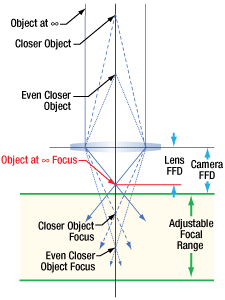
Click to Enlarge
Figure 11: Tolerance and / or temperature effects may result in the lens and camera having different FFDs. If the FFD of the lens is shorter, images of objects at infinity will be excluded from the focal range. Since the system cannot focus on them, they will be blurry.

Click to Enlarge
Figure 10: When their flange focal distances (FFD) are the same, the camera's sensor plane and the lens' focal plane are perfectly aligned. Images of objects at infinity coincide with one limit of the system's focal range.
Flange focal distance (FFD) values for cameras and lenses assume only air fills the space between the lens and the camera's sensor plane. If windows and / or filters are inserted between the lens and camera sensor, it may be necessary to increase the distance separating the camera's flange and sensor planes to a value beyond the specified FFD. A span equal to the FFD may be too short, because refraction through windows and filters bends the light's path and shifts the focal plane farther away.
If making changes to the optics between the lens and camera sensor, the resulting focal plane shift should be calculated to determine whether the separation between lens and camera should be adjusted to maintain good alignment. Note that good alignment is necessary for, but cannot guarantee, an in-focus image, since new optics may introduce aberrations and other effects resulting in unacceptable image quality.
A Case of the Bends: Focal Shift Due to Refraction
While travelling through a solid medium, a ray's path is straight (Figure 8). Its angle
When an optic with plane-parallel sides and a higher refractive index
While travelling through the optic, the ray approaches the optical axis at a slower rate than a ray travelling the same distance in air. After exiting the optic, the ray's angle with the axis is again θo , the same as a ray that did not pass through the optic. However, the ray exits the optic farther away from the axis than if it had never passed through it. Since the ray refracted by the optic is farther away, it crosses the axis at a point shifted Δf beyond the other ray's crossing. Increasing the optic's thickness widens the separation between the two rays, which increases Δf.
To Infinity and Beyond
It is important to many applications that the camera system be capable of capturing high-quality images of objects at infinity. Rays from these objects are parallel and focused to a point closer to the lens than rays from closer objects (Figure 9). The FFDs of cameras and lenses are defined so the focal point of rays from infinitely distant objects will align with the camera's sensor plane. When a lens has an adjustable focal range, objects at infinity are in focus at one end of the range and closer objects are in focus at the other.
Different effects, including temperature changes and tolerance stacking, can result in the lens and / or camera not exactly meeting the FFD specification. When the lens' actual FFD is shorter than the camera's, the camera system can no longer obtain sharp images of objects at infinity (Figure 11). This offset can also result if an optic is removed from between the lens and camera sensor.
An approach some lenses use to compensate for this is to allow the user to vary the lens focus to points "beyond" infinity. This does not refer to a physical distance, it just allows the lens to push its focal plane farther away. Thorlabs' Kiralux™ and Quantalux® cameras include adjustable C-mount adapters to allow the spacing to be tuned as needed.
If the lens' FFD is larger than the camera's, images of objects at infinity fall within the system's focal range, but some closer objects that should be within this range will be excluded. This situation can be caused by inserting optics between the lens and camera sensor. If objects at infinity can still be imaged, this can often be acceptable.
Not Just Theory: Camera Design Example
The C-mount, hermetically sealed, and TE-cooled Quantalux camera has a fixed 18.1 mm spacing between its flange surface and sensor plane. However, the FFD (f ) for C-mount camera systems is 17.526 mm. The camera's need for greater spacing becomes apparent when the focal shift due to the window soldered into the hermetic cover and the glass covering the sensor are taken into account. The results recorded in the table beneath Figure 9 show that both exact and paraxial equations return a required total spacing of 18.1 mm.
Date of Last Edit: July 31, 2020
Thorlabs offers three families of scientific cameras: Zelux®, Kiralux®, and Quantalux®. Zelux cameras are designed for general-purpose imaging and provide high imaging performance while maintaining a small footprint. Kiralux cameras have CMOS sensors in monochrome, color, NIR-enhanced, or polarization-sensitive versions and are available in low-profile, passively cooled housings; compact, passively cooled housings; or hermetically sealed, TE-cooled housings. The polarization-sensitive Kiralux camera incorporates an integrated micropolarizer array that, when used with our ThorCam™ software package, captures images that illustrate degree of linear polarization, azimuth, and intensity at the pixel level. Our Quantalux monochrome sCMOS cameras feature high dynamic range combined with extremely low read noise for low-light applications. They are available in either a compact, passively cooled housing or a hermetically sealed, TE-cooled housing. The tables below provide a summary of our camera offerings.
| Compact Scientific Cameras | |||||||
|---|---|---|---|---|---|---|---|
| Camera Type | Zelux® CMOS | Kiralux® CMOS | Quantalux® sCMOS | ||||
| 1.6 MP | 1.3 MP | 2.3 MP | 5 MP | 8.9 MP | 12.3 MP | 2.1 MP | |
| Item # | Monochrome: CS165MUa Color: CS165CUa |
Mono.: CS135MU Color: CS135CU NIR-Enhanced Mono.: CS135MUN |
Mono.: CS235MU Color: CS235CU |
Mono., Passive Cooling: CS505MU1 CS505MU Mono., Active Cooling: CC505MU Color: CS505CU1 CS505CU Polarization: CS505MUP1 |
Mono., Passive Cooling: CS895MU Mono., Active Cooling: CC895MU Color: CS895CU |
Mono., Passive Cooling: CS126MU LP126MU(/M) Mono., Active Cooling: CC126MU Color, Passive Cooling: CS126CU LP126CU(/M) |
Monochrome, Passive Cooling: CS2100M-USB Active Cooling: CC215MU |
| Product Photos (Click to Enlarge) |
 |
 |
 |
||||
| Electronic Shutter | Global Shutter | Global Shutter | Rolling Shutterb | ||||
| Sensor Type | CMOS | CMOS | sCMOS | ||||
| Number of Pixels |
1440 x 1080 (H x V) | 1280 x 1024 (H x V) | 1920 x 1200 (H x V) | 2448 x 2048 (H x V) | 4096 x 2160 (H x V) |
4096 x 3000 (H x V) |
1920 x 1080 (H x V) |
| Pixel Size | 3.45 µm x 3.45 µm | 4.8 µm x 4.8 µm | 5.86 µm x 5.86 µm | 3.45 µm x 3.45 µm | 5.04 µm x 5.04 µm | ||
| Optical Format |
1/2.9" (6.2 mm Diag.) |
1/2" (7.76 mm Diag.) |
1/1.2" (13.4 mm Diag.) |
2/3" (11 mm Diag.) |
1" (16 mm Diag.) |
1.1" (17.5 mm Diag.) |
2/3" (11 mm Diag.) |
| Peak Quantum Efficiency (Click for Plot) |
Monochrome: 69% at 575 nm Color: Click for Plot |
Monochrome: 59% at 550 nm Color: Click for Plot NIR: 60% at 600 nm |
Monochrome: 78% at 500 nm Color: Click for Plot |
Monochrome & Polarization: 72% (525 to 580 nm) Color: Click for Plot |
Monochrome: 72% (525 to 580 nm) Color: Click for Plot |
Monochrome: 72% (525 to 580 nm) Color: Click for Plot |
Monochrome: 61% (at 600 nm) |
| Max Frame Rate (Full Sensor) |
34.8 fps | 165.5 fps | 39.7 fps | 35 fps (CS505xx1, CC505MU, CS505MUP1), 53.2 fps (CS505xx) |
20.8 fps (CC895MU), 30.15 fps (CS895xx) |
15.1 fps (CC126MU), 21.7 fps (CS126xx and LP126xx(/M)) |
50 fps |
| Read Noise | <4.0 e- RMS | <7.0 e- RMS | <7.0 e- RMS | <2.5 e- RMS | <1 e- Median RMS; <1.5 e- RMS | ||
| Digital Output |
10 Bit (Max) | 10 Bit (Max) | 12 Bit (Max) | 16 Bit (Max) | |||
| PC Interface | USB 3.0 | ||||||
| Available Fanless Cooling |
N/A | N/A | N/A | 15 °C to 20 °C Below Ambient Temperature (CCxxxMU Cameras Only) | |||
| Housing Size (Click for Details) |
0.59" x 1.72" x 1.86" (15.0 x 43.7 x 47.2 mm3) |
Passively Cooled CMOS Camera TE-Cooled CMOS Camera Passively Cooled Low-Profile CMOS Camera |
Passively Cooled sCMOS Camera TE-Cooled sCMOS Camera |
||||
| Typical Applications |
Mono. & Color: Brightfield Microscopy, General Purpose Imaging, Machine Vision, Material Sciences, Materials Inspection, Monitoring, Transmitted Light Spectroscopy, UAV, Drone, & Handheld Imaging Mono. Only: Multispectral Imaging, Semiconductor Inspection Color Only: Histopathology |
Mono., Color, & NIR: Brightfield Microscopy, Ca++ Ion Imaging, Electrophysiology/Brain Slice Imaging, Flow Cytometry, Fluorescence Microscopy, General Purpose Imaging, Immunohistochemistry (IHC), Laser Speckle Imaging, Machine Vision, Material Sciences, Materials Inspection, Vascular Imaging, Monitoring, Particle Tracking, Transmitted Light Spectroscopy, Vascular Imaging, VIS/NIR Imaging Mono. Only: Multispectral Imaging Semiconductor Inspection Color Only: Histopathology NIR Only: Ophthalmology/Retinal Imaging |
Mono. & Color: Autofluorescence, Brightfield Microscopy, Electrophysiology/Brain Slice Imaging, Fluorescence Microscopy, Immunohistochemistry (IHC), Machine Vision, Material Sciences, Materials Inspection, Monitoring, Quantitative Phase-Contrast Microscopy, Transmitted Light Microscopy Mono. Only: Multispectral Imaging Semiconductor Inspection Color Only: Histopathology |
Mono. & Color: Autofluorescence, Brightfield Microscopy, Electrophysiology/Brain Slice Imaging, Fluorescence Microscopy, Immunohistochemistry (IHC), Machine Vision, Material Sciences, Materials Inspection, Monitoring, Quantitative Phase-Contrast Microscopy, Transmitted Light Microscopy Mono. Only: Multispectral Imaging, Semiconductor Inspection Color Only: Histopathology Polarization Only: Inspection, Surface Reflection Reduction, Transparent Material Detection |
Mono. & Color: Autofluorescence, Brightfield Microscopy, Electrophysiology/Brain Slice Imaging, Fluorescence Microscopy, Immunohistochemistry (IHC), Machine Vision, Material Science, Materials Inspection, Monitoring, Quantitative Phase-Contrast Microscopy, Transmitted Light Microscopy Mono. Only: Multispectral Imaging, Ophthalmology/Retinal Imaging, Semiconductor Inspection Color Only: Histopathology LP126xx(/M), CS126xx, and CC126MU Only: Whole-Slide Microscopy |
Passive & Active Cooling: Autofluorescence, Brightfield Microscopy, Fluorescence Microscopy, Immunohistochemistry (IHC), Material Sciences, Materials Inspection, Monitoring, Quantitative Phase-Contrast Microscopy, Quantum Dots, Semiconductor Inspection, Transmitted Light Microscopy, Whole-Slide Microscopy Active Cooling Only: Electrophysiology/Brain Slice Imaging, Multispectral Imaging |
|
| Posted Comments: | |
Ym Zhang
(posted 2024-03-28 12:22:03.98) LC100 is Discontinued, Are there alternatives? cwright
(posted 2024-04-03 09:59:48.0) Response from Charles at Thorlabs: Thank you for contacting us. Unfortunately there is not a direct alternative for the LC100 line camera. We will reach out to you to discuss your application and see if we have a suitable solution for you. Jesse Wilson
(posted 2024-03-11 09:23:26.31) Do you have dark current specs on the CS135MUN? Thanks,
-Jesse cdolbashian
(posted 2024-03-15 04:21:57.0) Thank you for reaching out to us Jesse. Unfortunately we do not have such a spec for these cameras. I have contacted you directly in order to discuss your application, and the applicability of our cameras therein. user
(posted 2024-01-09 14:41:54.933) CS126CU - has an ADC resolution of 12 bits. The live data on thorcam outputs this fine (pixel values 0-4095). However, when saving still images, there are no 12-bit options. Most options are 8-bit format (BMP, JPG, PNG), and one option for a 16-bit TIF format. Attempts to read in the full 12-bit information from the 16-bit TIF file have failed. The image properties of this file state a bit depth of 24 - implying 8-bit per channel. How can the full dynamic range of the camera be stored in the saved image file for analysis purposes? jpolaris
(posted 2024-02-19 03:11:34.0) Thank you for contacting Thorlabs. On modern computers, 8 and 16 bit images are standard, but you can still save other bit depths using these formats. We tested this on a CS505CU (which has the same bit depth as CS126CU) and did not see any issues. The bit depth in windows shows as 16, but the data in the file itself is in 12-bit format. ThorCam has several save options, and it might be possible that you have an 8-bit option selected. When saving a 12-bit image in 8-bit, each pixel is scaled according to the max integer value supported by that format. E.g., New Pixel Value = (Old Pixel Value) * (256/4096), rounded to the nearest integer. When saving a 12-bit image in a 16-bit format, no changes need to be made to the data. The upper 4 bits of the pixel data just aren't used. I have reached out to you directly. Pinrui Shen
(posted 2022-11-08 17:12:41.303) Hi, we have been using the camera CS895CU to monitor the dynamics of the atoms.
We used the camera under its hardware triggering mode and the trigger signal is sent through the thorlabs breakout board.
However, after a week of not using the camera, we just found the camera does not response to the hardware trigger anymore.
We made sure the cables and breakout board are ok.
The camera still works under the software triggering mode.
The problem seems like the camera can be put in the hardware triggering mode but it ignores the trigger signals.
Do you know what could happen, is it possible the chip inside the camera is broken?
Thanks for the help! cdolbashian
(posted 2022-11-16 11:44:22.0) Thank you for reaching out to us with this inquiry. I have contacted you directly to troubleshoot your issue. Chris James
(posted 2021-12-05 08:00:28.787) hello,
We use CS235MU cameras in our laboratory. There doesn't seem to be a lot of information around about what the gain corresponds to, is there a table anywhere which converts the gain input values into units of dB so we know what it corresponds to?
thank you, that would be very useful! YLohia
(posted 2021-12-07 10:53:13.0) Hello, thank you for contacting Thorlabs. The gain adjustment value is 0.1 dB per step. More information can be found on Page 8 of the ThorCam manual. Ludo Angot
(posted 2021-10-01 00:29:21.39) Hello, could you provide the QE curve of your monochrome kiralux cameras (any model with resolution >=5Mp) below 400nm, down to 300nm? YLohia
(posted 2021-10-11 02:51:04.0) Hello, the QE of all our CMOS sensors drops precipitously around 350 nm due to the sensor, cover glass, and the polymer microlens array deposited on the silicon. However, if the cover glass is removed, there is some response (I have reached out to you directly with this information). The cover glass removal is sensitive process due to the delicate nature of the sensor and wirebonds and, because the sensor is exposed, great care must be taken to avoid particulate contamination. Bruno Chazelas
(posted 2021-06-04 02:57:46.42) Hello,
I do not manage to understand if the kiralux camera has a linux driver. Is it the case
Cheers
Bruno Chazelas YLohia
(posted 2021-06-04 02:48:31.0) Hello, the Linux SDK can be downloaded from the website under the software page: https://www.thorlabs.com/software_pages/ViewSoftwarePage.cfm?Code=ThorCam (Navigate to 'Programming Interfaces' tab, then to the' Linux SDK and Doc. for Compact Scientific Cameras' section to download the software). These materials are included with ThorCam and are also available separately on the Programming Interfaces tab, where we also offer a Linux SDK for our Compact Scientific Cameras, excluding the 1.3 MP Kiralux™ cameras at the moment. As of this post, all other Kiralux models are compatible with Linux. Jacopo Forneris
(posted 2020-10-01 08:17:06.537) Dear Sir/Madam,
are the Kiralux CMOS cameras vacuum compatibile (1e-5.1e-6 mbar)? If not, are there other scientific cameras from your catalogue that can be used under these UHV conditions?
Thank you and best regards,
Jacopo Forneris YLohia
(posted 2020-10-01 11:41:05.0) Hello Jacopo, thank you for contacting Thorlabs. Unfortunately, the Kiralux cameras are not vacuum-compatible and neither are our other camera offerings. |
Camera Selection Tool
Reset Parametersof 31 Products Shown
Select Parameters
Select Applications
of 31 Products Shown
| Item Number | Sensor Type | Optical Format | Electronic Shutter | Pixel Size | Max Frame Rate | Read Noise | Digital Output | Cooling | Housing Dimensions |
|---|

| Kiralux 1.3 MP Camera Comparisona | |||
|---|---|---|---|
| Item # | Sensor Type | Peak Quantum Efficiencyb |
Removable Optic |
| CS135MU | Monochrome CMOS | 59% at 550 nm | AR-Coated Window, Ravg < 0.5% per Surface (400 - 700 nm) |
| CS135CU | Color CMOS | Click for Plot | IR Blocking Filterb |
| CS135MUN | NIR-Enhanced CMOS | 60% at 600 nm | AR-Coated Window, Ravg < 0.5% per Surface (650 - 1050 nm) |
- Max Frame Rate: 165.5 fps (Full Sensor)
- Read Noise: <7.0 e- RMS
- Fanless Passive Thermal Management
- SM1-Threaded (1.035"-40) Aperture with Adapter for Standard C-Mount (1.000"-32)
Applications
|
|
Images of an arm taken using a Kiralux NIR-Enhanced 1.3 MP CMOS Camera with a shortpass filter (left) or longpass filter (right). The image on the left shows the arm's surface, while the veins beneath the skin are clearly visible in the NIR image on the right.

| Kiralux 2.3 MP Camera Comparisona | |||
|---|---|---|---|
| Item # | Sensor Type | Peak Quantum Efficiencyb |
Removable Optic |
| CS235MU | Monochrome CMOS | 78% at 500 nm | AR-Coated Window, Ravg < 0.5% per Surface (400 - 700 nm) |
| CS235CU | Color CMOS | Click for Plot | IR Blocking Filterb |
- Max Frame Rate: 39.7 fps (Full Sensor)
- Read Noise: <7.0 e- RMS
- Fanless Passive Thermal Management
- SM1-Threaded (1.035"-40) Aperture with Adapter for Standard C-Mount (1.000"-32)
Applications
|
|

Click here to view the full-resolution image.
This merged triple-emission fluorescence image of FluoCells® prepared BPAE cells was acquired using the CS235MU Monochrome Camera. The 16-bit full-resolution image downloads may be viewed using ThorCam, ImageJ, or other scientific imaging software. They may not be displayed correctly in general-purpose image viewers.
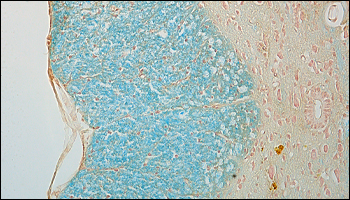
Click here to view the full-resolution image.
This image of a mouse cervical spinal cord cross section (stained with neutral red and luxol fast blue) was acquired using the CS235CU Camera. Sample Prepared by Dr. Tak Ho Chu and Dr. Peter K. Stys at the University of Calgary.

| Kiralux 5.0 MP Camera Comparisona | ||||
|---|---|---|---|---|
| Item # | Sensor Type | Max Frame Rate (Full Sensor) | Peak Quantum Efficiencyb | Removable Optic |
| CS505MU1 | Monochrome CMOS | 35 fps | 72% Over 525 to 580 nm | AR-Coated Window, Ravg < 0.5% per Surface (400 - 700 nm) |
| CS505MU | 53.2 fps | |||
| CS505CU1 | Color CMOS | 35 fps | Click for Plot | IR Blocking Filterb |
| CS505CU | 53.2 fps | |||
- Two Frame Rate Models:
- Standard Frame Rate: 35 fps (Full Sensor)
- High Frame Rate: 53.2 fps (Full Sensor)
- Read Noise: <2.5 e- RMS
- Fanless Passive Thermal Management
- SM1-Threaded (1.035"-40) Aperture with Adapter for Standard C-Mount (1.000"-32)
Applications
|
|

Click here to view the full-resolution image.
A FluoCells® #1 slide imaged with our CS505MU Compact Scientific Camera using an excitation wavelength of 560 nm, 20X/0.75 NA objective, and 1 second exposure. The 16-bit full-resolution image download may be viewed using ThorCam, ImageJ, or other scientific imaging software. It may not be displayed correctly in general-purpose image viewers.

Click here to view the full-resolution image.
Ki-67 stained sample at 20X magnification, showing the suitability of the CS505CU color camera in IHC applications.
Note: Thorlabs also offers the CS505MUP1 5.0 MP Monochrome CMOS Polarization Camera, which is ideal for applications that would benefit from illustrating the degree of linear polarization, such as materials inspection or stress-induced birefringence detection. This camera features an integrated wire grid polarizer array on the sensor chip between the microlens array and the photodiodes; see the full web presentation for details.

| Kiralux Cooled 5.0 MP Camera Key Specsa | |||
|---|---|---|---|
| Item # | Sensor Type | Peak Quantum Efficiencyb | Removable Optic |
| CC505MU | Monochrome CMOS |
72% Over 525 to 580 nm | AR-Coated Window, Ravg < 0.5% per Surface (400 - 700 nm) |
- Max Frame Rate: 35 fps (Full Sensor)
- Read Noise: <2.5 e- RMS
- Fanless Thermoelectric Cooling
- Factory Installed Adapter for Standard C-Mount (1.000"-32) Compatibility
The CC505MU hermetically sealed cooled Kiralux camera is designed with a thermoelectrically cooled chamber inside a large external heat sink to actively cool the sensor and reduce dark shot noise. This results in a 10x improvement in dark current over the passively cooled CS505MU camera and improved performance at longer exposures. We recommend this camera for applications with low light levels requiring an exposure time greater than 500 ms. For high light levels requiring short exposure times (less than 500 ms), the passively cooled CS505MU camera is generally sufficient.
The position of the monochrome, 2/3" format CMOS sensor is approximately in line with the four front 1/4"-20 mounting holes, one located on each side of the housing. A removable C-mount adapter on the front end of the camera holds a clear protective window (AR coated for 400 - 700 nm) that can be removed and replaced by another Ø1" (Ø25 mm) optic up to 0.079" (2.0 mm) thick. Please note that dust and debris may collect on the hermetic chamber glass covering while the clear window is removed. Care must be taken when cleaning this covering to avoid scratching or other damage to the glass.
The factory installed C-mount (1.000"-32) adapter has a fixed flange focal distance and provides out-of-the-box compatibility with many microscopes, machine vision camera lenses, and C-mount extension tubes. The camera can be connected to our 60 mm cage system via four 4-40 mounting holes on the front of the housing, and 1/4"-20 tapped holes on the sides are provided for use with our imperial Ø1" pedestal or pillar posts. These flexible mounting options provide compatibility with commercial microscopes and support integration into home-built imaging systems.
Due to supply chain disruptions, the CC505MU is experiencing atypically long lead times. While the
situation is improving, our commitment to returning this item to same-day shipment continues.

| Kiralux 8.9 MP Camera Comparisona | |||
|---|---|---|---|
| Item # | Sensor Type | Peak Quantum Efficiencyb | Removable Optic |
| CS895MU | Monochrome CMOS | 72% Over 525 to 580 nm | AR-Coated Window, Ravg < 0.5% per Surface (400 - 700 nm) |
| CS895CU | Color CMOS | Click for Plot | IR Blocking Filterb |
- Max Frame Rate: 30.15 fps (Full Sensor)
- Read Noise: <2.5 e- RMS
- Fanless Passive Thermal Management
- Large Field of View
- SM1-Threaded (1.035"-40) Aperture with Adapter for Standard C-Mount (1.000"-32)
Applications
|
|
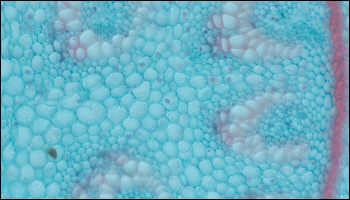
Click here to view the full-resolution image.
This image of Convallaria majalis rhizome with concentric vascular bundles was acquired using the CS895CU Color Camera. The 16-bit full-resolution image downloads may be viewed using ThorCam, ImageJ, or other scientific imaging software. They may not be displayed correctly in general-purpose image viewers.
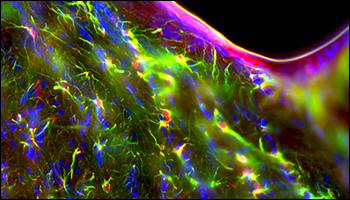
Click here to view the full-resolution image.
Three-channel immunofluorescence image of a mouse brain
acquired using the CS895MU Camera. Sample prepared by Lynne Holtzclaw of the NICDH Microscopy and Imaging Core Facility, NIH, Bethesda, MD.

| Kiralux Cooled 8.9 MP Camera Key Specsa | |||
|---|---|---|---|
| Item # | Sensor Type | Peak Quantum Efficiencyb | Removable Optic |
| CC895MU | Monochrome CMOS |
72% Over 525 to 580 nm | AR-Coated Window, Ravg < 0.5% per Surface (400 - 700 nm) |
- Max Frame Rate: 20.8 fps (Full Sensor)
- Read Noise: <2.5 e- RMS
- Fanless Thermoelectric Cooling
- Factory Installed Adapter for Standard C-Mount (1.000"-32) Compatibility
The CC895MU hermetically sealed cooled Kiralux camera is designed with a thermoelectrically cooled chamber inside a large external heat sink to actively cool the sensor and reduce dark shot noise. This results in a 10x improvement in dark current over the passively cooled CS895MU camera and improved performance at longer exposures. We recommend this camera for applications with low light levels requiring an exposure time greater than 500 ms. For high light levels requiring short exposure times (less than 500 ms), the passively cooled CS895MU camera is generally sufficient.
The position of the monochrome, 2/3" format CMOS sensor is approximately in line with the four front 1/4"-20 mounting holes, one located on each side of the housing. A removable C-mount adapter on the front end of the camera holds a clear protective window (AR coated for 400 - 700 nm) that can be removed and replaced by another Ø1" (Ø25 mm) optic up to 0.079" (2.0 mm) thick. Please note that dust and debris may collect on the hermetic chamber glass covering while the clear window is removed. Care must be taken when cleaning this covering to avoid scratching or other damage to the glass.
The factory installed C-mount (1.000"-32) adapter has a fixed flange focal distance and provides out-of-the-box compatibility with many microscopes, machine vision camera lenses, and C-mount extension tubes. The camera can be connected to our 60 mm cage system via four 4-40 mounting holes on the front of the housing, and 1/4"-20 tapped holes on the sides are provided for use with our imperial Ø1" pedestal or pillar posts. These flexible mounting options provide compatibility with commercial microscopes and support integration into home-built imaging systems.
Due to supply chain disruptions, the CC895MU is experiencing atypically long lead times. While the
situation is improving, our commitment to returning this item to same-day shipment continues.

Applications
|
|
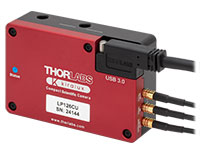
Click to Enlarge
Image of the back of an LP126CU camera with the USB 3.0 right angle cable and three MMCX-to-BNC cables connected.
- Max Frame Rate: 21.7 fps (Full Sensor)
- Read Noise: <2.5 e- RMS
- SM1-Threaded (1.035"-40) Aperture with Adapter for Standard C-Mount (1.000"-32)
- Low-Profile Housing (L x H x W): 3.00" x 2.00" x 0.90" (76.2 mm x 50.8 mm x 22.9 mm)
- Fanless Passive Thermal Management
The LP126xU(/M) scientific camera series features a 12.3 MP monochrome or color CMOS sensor packaged in a passively cooled, low-profile housing. The low-profile design (3.00" x 2.00" x 0.90") enables the user to mount the camera into space constrained optical paths. The LP126xU(/M) cameras feature two 1/4"-20 (M6 x 1.0) threaded holes on both the top and bottom and one 1/4"-20 (M6 x 1.0) threaded hole on the side. Mounting the LP126xU(/M) camera using both tapped holes on the top or bottom prevents the camera from being rotated while mounted. The LP126MU(/M) and LP126CU(/M) cameras are shipped with a pre-installed and removable Ø25 mm AR-coated window or a Ø25 mm IR blocking filter, respectively. The optic can be replaced with either a Ø25 mm or Ø1" (Ø25.4 mm) optic with a thickness of 0.039" (1.0 mm) when using the DC-CS1 C-mount to SM1 threaded adapter. Without the adapter, the maximum optic thickness is 0.196" (5.0 mm). White lines visible on the top, bottom, and side of the the camera mark the location of the CMOS sensor surface (please see the mechanical drawing on the Specs tab for more details).
| Kiralux 12.3 MP Low-Profile Camera Comparisona | |||
|---|---|---|---|
| Item # | Sensor Type | Peak Quantum Efficiencyb | Removable Optic |
| LP126MU(/M) | Monochrome CMOS | 72% Over 525 to 580 nm | AR-Coated Window, Ravg < 0.5% per Surface (400 - 700 nm) |
| LP126CU(/M) | Color CMOS | Click for Plot | IR Blocking Filterb |

| Kiralux 12.3 MP Camera Comparisona | |||
|---|---|---|---|
| Item # | Sensor Type | Peak Quantum Efficiencyb | Removable Optic |
| CS126MU | Monochrome CMOS | 72% Over 525 to 580 nm | AR-Coated Window, Ravg < 0.5% per Surface (400 - 700 nm) |
| CS126CU | Color CMOS | Click for Plot | IR Blocking Filterb |
- Max Frame Rate: 21.7 fps (Full Sensor)
- Read Noise: <2.5 e- RMS
- Fanless Passive Thermal Management
- Large Field of View
- SM1-Threaded (1.035"-40) Aperture with Adapter for Standard C-Mount (1.000"-32)
Applications
|
|

Click here to view the full-resolution image.
This large field of view image of Peyer's patches in a sample of human ileum tissue at 20X magnification was acquired using the CS126CU Color Camera. The red border illustrates the field of view of an image acquired from the same sample using the CS235CU Color Camera sold above (download). The 16-bit full-resolution image downloads may be viewed using ThorCam, ImageJ, or other scientific imaging software. They may not be displayed correctly in general-purpose image viewers.

Click here to view the full-resolution image.
This four-channel fluorescence image of Convallaria majalis rhizome with concentric vascular bundles at 20X magnification was acquired using the CS126MU Camera.

| Kiralux Cooled 12.3 MP Camera Key Specsa | |||
|---|---|---|---|
| Item # | Sensor Type | Peak Quantum Efficiencyb | Removable Optic |
| CC126MU | Monochrome CMOS |
72% Over 525 to 580 nm | AR-Coated Window, Ravg < 0.5% per Surface (400 - 700 nm) |
- Max Frame Rate: 15.1 fps (Full Sensor)
- Read Noise: <2.5 e- RMS
- Fanless Thermoelectric Cooling
- Factory Installed Adapter for Standard C-Mount (1.000"-32) Compatibility
The CC126MU hermetically sealed cooled Kiralux camera is designed with a thermoelectrically cooled chamber inside a large external heat sink to actively cool the sensor and reduce dark shot noise. This results in a 10x improvement in dark current over the passively cooled CS126MU camera and improved performance at longer exposures. We recommend this camera for applications with low light levels requiring an exposure time greater than 500 ms. For high light levels requiring short exposure times (less than 500 ms), the passively cooled CS126MU camera is generally sufficient.
The position of the monochrome, 2/3" format CMOS sensor is approximately in line with the four front 1/4"-20 mounting holes, one located on each side of the housing. A removable C-mount adapter on the front end of the camera holds a clear protective window (AR coated for 400 - 700 nm) that can be removed and replaced by another Ø1" (Ø25 mm) optic up to 0.079" (2.0 mm) thick. Please note that dust and debris may collect on the hermetic chamber glass covering while the clear window is removed. Care must be taken when cleaning this covering to avoid scratching or other damage to the glass.
The factory installed C-mount (1.000"-32) adapter has a fixed flange focal distance and provides out-of-the-box compatibility with many microscopes, machine vision camera lenses, and C-mount extension tubes. The camera can be connected to our 60 mm cage system via four 4-40 mounting holes on the front of the housing, and 1/4"-20 tapped holes on the sides are provided for use with our imperial Ø1" pedestal or pillar posts. These flexible mounting options provide compatibility with commercial microscopes and support integration into home-built imaging systems.
Due to supply chain disruptions, the CC126MU is experiencing atypically long lead times. While the
situation is improving, our commitment to returning this item to same-day shipment continues.

These optional accessories allow for easy use of the auxiliary and connection ports of our compact, low-profile, or actively-cooled scientific sCMOS & CMOS cameras. These items should be considered when it is necessary to externally trigger the camera, to monitor camera performance with an oscilloscope, or for simultaneous control of the camera with other instruments.
For our USB 3.0 cameras, we also offer a PCIe USB 3.0 card for facilitating the connection to the computer.
Auxiliary I/O Cables (8050-CAB1, CA3339, and CA3439)
The 8050-CAB1 is a 10' (3 m) long cable that mates with the auxiliary connector on our CS and CC series scientific cameras* and provides the ability to externally trigger the camera as well as monitor status output signals. One end of the cable features a male 12-pin connector for connecting to the camera, while the other end has a male 6-pin Mini Din connector for connecting to external devices. This cable is ideal for use with our interconnect break-out boards described below. For information on the pin layout, please see the Pin Diagrams tab above.
*The 8050-CAB1 cable is not compatible with the LP series cameras or our former-generation 1500M series cameras.
The CA3339 and CA3439 are 1 m long RG-174 cables that have an MMCX jack on one end and a BNC or SMA jack on the other end, respectively. Three CA3339 MMCX-to-BNC cables are shipped with the LP series cameras to provide the ability to externally trigger, synchronize external equipment, and monitor output signals of the camera. The MMCX jack mates with the camera and the BNC connector can connect to external devices. The CA3439 MMCX-to-SMA cable is an optional cable that can be used with the TSI-IOBOB2 for additional breakout functionality (See Interconnect Break-Out Board / Shield For Arduino section below and the Triggering tab for more details).
Interconnect Break-Out Board (TSI-IOBOB)
The TSI-IOBOB is designed to "break out" the 6-pin Mini Din connector found on our scientific camera auxiliary cables into five SMA connectors. The SMA connectors can then be connected using SMA cables to other devices to provide a trigger input to the camera or to monitor camera performance. The pin configurations are listed on the Pin Diagrams tab above.
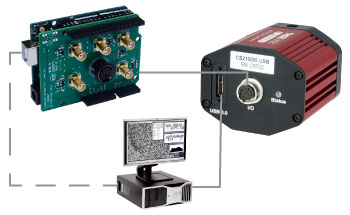
Click for Details
A schematic showing a TSI-IOBOB2 connected to an Arduino to trigger a compact scientific camera.
Interconnect Break-Out Board / Shield for Arduino (TSI-IOBOB2)
The TSI-IOBOB2 offers the same breakout functionality of the camera signals as the TSI-IOBOB. Additionally, it functions as a shield for Arduino, by placing the TSI-IOBOB2 shield on a Arduino board supporting the Arduino Uno Rev. 3 form factor. While the camera inputs and outputs are 5 V LVTTL, the TSI-IOBOB2 features bi-directional logic level converters to enable compatibility with Arduino boards operating on either 5 V or 3.3 V logic. Sample programs for controlling the scientific camera are available for download from our software page, and are also described in the manual (found by clicking on the red Docs icon below). For more information on Arduino, or for information on purchasing an Arduino board, please see www.arduino.cc.
The image to the right shows a schematic of a configuration with the TSI-IOBOB2 with an Arduino board integrated into a camera imaging system. The camera is connected to the break-out board using a 8050-CAB1 cable that must be purchased separately. The pins on the shield can be used to deliver signals to simultaneously control other peripheral devices, such as light sources, shutters, or motion control devices. Once the control program is written to the Arduino board, the USB connection to the host PC can be removed, allowing for a stand-alone system control platform; alternately, the USB connection can be left in place to allow for two-way communication between the Arduino and the PC. A similar setup can be configured for the LP series low-profile cameras using three CA3439 MMCX-to-SMA cables, sold separately. Please see the Triggering tab for more details on connecting the Compact Series and Low-Profile series cameras to the TSI-IOBOB2 and other external devices. The compact size of 2.70" x 2.10" (68.6 mm x 53.3 mm) also aids in keeping systems based on the TSI-IOBOB2 compact.
USB 3.0 Camera Accessories (CABU31, CABU32, and USB3-PCIE)
We also offer two USB 3.0 A to Micro B cables for connecting our cameras to a PC (please note that one straight cable is included with each camera). The CABU31 cable has a straight Micro-B connector that features screws on either side that mate with tapped holes for securing the connector to the device. The CABU32 cable has a right-angle connector with a single locking screw. Both cables measure 118" long.
Cameras with USB 3.0 connectivity may be connected directly to the USB 3.0 port on a laptop or desktop computer. USB 3.0 cameras are not compatible with USB 2.0 ports. Host-side USB 3.0 ports are often blue in color, although they may also be black in color, and typically marked "SS" for SuperSpeed. A USB 3.0 PCIe card is sold separately for computers without an integrated Intel USB 3.0 controller. Note that the use of a USB hub may impact performance. A dedicated connection to the PC is preferred.

The SM1A10A and DC-CS1 are replacement SM1 to C-Mount adapters for the CS series compact cameras and LP series low-profile cameras, respectively. These adapters have external SM1 (1.035"-40) threads and internal C-mount (1.000"-32) threads for compatibility with many microscopes, machine vision camera lenses, and C-Mount extension tubes. The SM1A10A adapter also comes with an SM1NT locking ring. Using the SM1A10A adapter with a CS series compact camera and the DC-CS1 adapter with an LP series low-profile camera sets the correct flange focal distance (FFD) for use with C-mount lenses. Please see the Insights tab for more details on C-mount adapters and lenses.
 Products Home
Products Home


















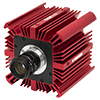



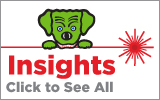
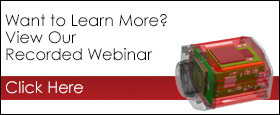

 Zoom
Zoom
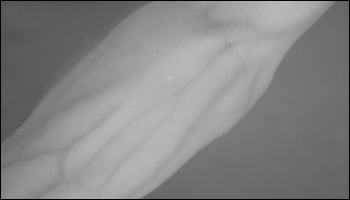



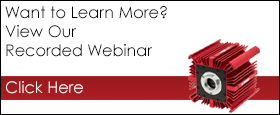

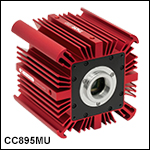



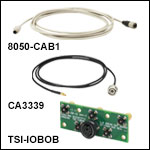



 1.3 MP - 12.3 MP CMOS Compact Microscopy Cameras
1.3 MP - 12.3 MP CMOS Compact Microscopy Cameras